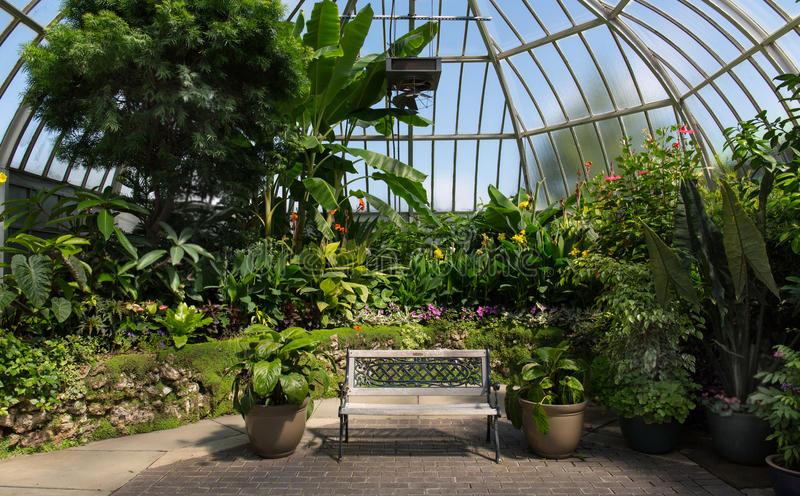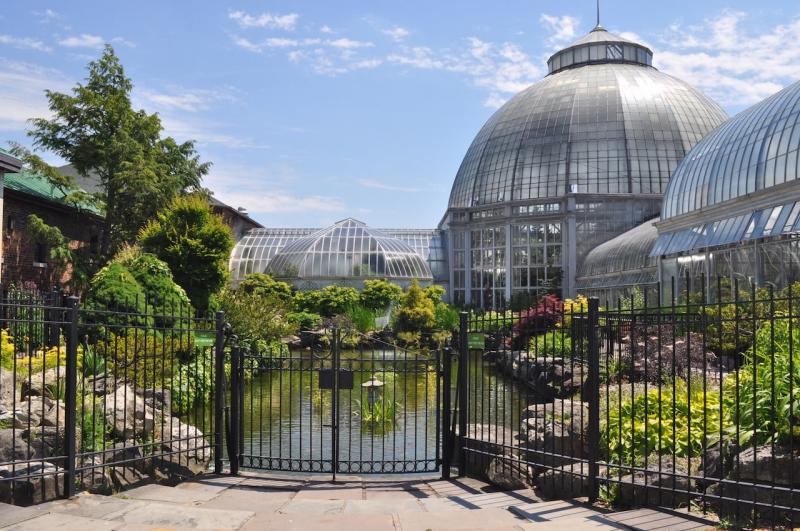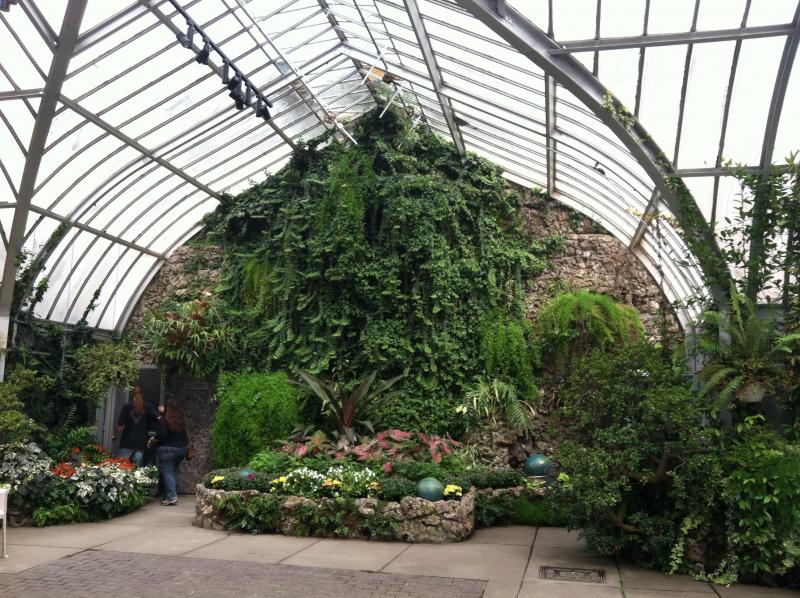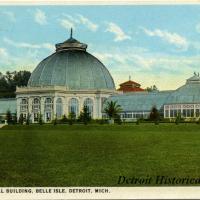-
Name of property current (historical)
-
Anna Scripps Whitcomb Conservatory
-
Entry author
-
Haley Cope
-
Abstract
-
The Anna Scripps Whitcomb Conservatory is located on Belle Isle in Detroit, Michigan. It is currently the oldest continually running conservatory in the United States. The Conservatory began construction in 1902 and opened its doors in 1904. It has seen millions of visitors over the years and continues to remain open to the public. Through countless donations and volunteers the Anna Scripps Whitcomb Conservatory remains a staple of the Detroit Community.
-
Address
-
300 River Place Dr Ste 2800, Detroit, MI 48207
-
Architect
-
Albert Kahn & George Mason, they also were the architects who designed the Belle Isle Aquarium directly next to the Conservatory.
-
Date (comission)
-
1902
-
Date (completion)
-
1904
-
Program/ function
-
Greenhouse & Botanical Garden
-
Contractor
-
The City of Detroit commissioned the Conservatory in 1902. The conservatory was a part of a much larger movement to beautify large industrial cities through parks. This was known as “ The City Beautiful Movement” which was developed during and after the Columbian Exposition in Chicago around 1893. This had a very large impact on urban planning around the United States and Detroit was no exception. The efforts to beautify Belle Isle through the Conservatory and other attractions was a success. During the mid 1920’s the conservatory averaged 1.5 million visitors a year.
-
Date (modification, adaptation, renovation)
-
1953-Wood framing is replaced with a steel frame ($500,000 equivalent to $4.4 Million today)
2022- Renovation in progress ($10 million)
-
Style/ distinct features/ cultural reference
-
The Conservatory can be classified as a European Modernist style. Many of its elements were inspired by Thomas Jefferson's Monticello home. It was originally constructed of glass and a wooden frame.
-
Gift giver/ funder/ contributor
-
Prior to 1955 the Anna Scripps Whitcomb Conservatory was known as the Horticulture Building or the Conservatory. In 1953 the Conservatory was gifted 600 rare orchids from Anna Scripps Whitcomb’s private collection. Many of these orchids were rescued from Britain during World War ll. Because of her donation, the City of Detroit became home to one of the largest municipally owned orchid collections in the United Stats. In honor of her donation, the Conservatory was renamed on April 6th, 1955 to The Anna Scripps Whitcomb Conservatory.
There are many benefactors and volunteers today that help keep the conservatory running. Belle Isle Conservancy is a non profit organization dedicated to keeping Belle Isle beautiful and running. They are a result of four merging groups dedicated to supporting the park. This organization works closely with the Michigan Department of Natural Resources and the City of Detroit.
-
Beneficiaries and impact on the community
-
The conservatory was a part of a much larger movement to beautify large industrial cities through parks. This was known as “ The City Beautiful Movement” which was developed during and after the Columbian Exposition in Chicago around 1893. This had a very large impact on urban planning around the United States and Detroit was no exception. The efforts to beautify Belle Isle through the Conservatory and other attractions was a success. During the mid 1920’s the conservatory averaged 1.5 million visitors a year.
-
Was it part of a network of buildings?
-
Anna Scripps Whitcomb Conservatory is part of a much larger network of buildings and sites located on Bell Isle. Those being the Belle Isle Aquarium, Belle Isle Casino, Belle Isle Zoo, and Belle Isle Park.
-
Sustainability (financial, cultural)
-
The Anna Scripps Whitcomb Conservatory is currently the oldest continually running conservatory in the United States.
-
Size/ scale
-
566,280
-
Q1: What were the motivations of the gift-giver and the implications of the gift for the community ?
-
Anna Scripps Whitcomb was known as an American philanthropist. Her and her husband Edgar were prominent benefactors of the Detroit Institutes of Art. Prior to her passing, Anna wanted to ensure her collections would be enjoyed and maintained by the community. In 1953 the Conservatory was gifted 600 rare orchids from Anna Scripps Whitcomb’s private collection, while the Detroit Institutes of Art also received Whitcomb's private art collection. Anna Scripps Whitcomb’s donation after her passing had very large implications on the Detroit community. During the early 1900’s orchids were very challenging to find or germinate, this made Anna’s collection even more impressive. Because of her donation to the conservatory, the City of Detroit became home to one of the largest municipally owned orchid collections in the United States. This new found title brought a great deal of attention to the conservatory, bringing in visitors from all over to observe this beautiful, orchid collection. In honor of her donation, the Conservatory was renamed on April 6th, 1955 to The Anna Scripps Whitcomb Conservatory.
-
Q2: Was there an imposed sense of responsibility or reciprocation in the case study, and who were the parties that were charged with these actions?
-
There is often a sense of responsibility or reciprocation when a gift is given or received. Anna Scripps Whitcomb Conservatory is no exception to this. The conservatory has been supported by the city of Detroit, which has provided funding for its maintenance and upkeep. In addition, the Friends of Belle Isle Conservancy, a nonprofit organization, has been instrumental in promoting and supporting the conservatory, as well as other attractions on Belle Isle. The community has also been involved in the conservatory through volunteer programs and events. The conservatory relies on volunteers to help maintain the plants and keep the facility running smoothly. The Belle Isle Conservancy also hosts a variety of events and programs throughout the year, including plant sales, garden tours, and educational workshops.
The obligation of maintenance of the Anna Scripps Whitcomb Conservatory could be credited to the Civic Pride of Detroiters. Detroit civic pride is a strong sense of attachment and loyalty that residents of Detroit feel towards their city. It is rooted in the history, culture, and resilience of the city and its people. Despite facing challenges such as economic decline, urban decay, and racial tensions, Detroiters have a deep love and commitment to their city. This is reflected in the many community-led initiatives working to revitalize neighborhoods and promote social and economic equity. The Anna Scripps Whitcomb Conservatory has been embraced by the Detroit community as a cherished attraction and cultural resource. Its ongoing success and sustainability rely on the support and involvement of the community it serves.
-
Q3: Do the design characteristics (i.e material, layout, location) reflect either the culture of the giver, the culture of the receiver, or a mixture of both?
-
The Anna Scripps Whitcomb Conservatory underwent a major renovation in 1955, shortly after the donation of Anna Scripps Whitcomb’s collection of orchids. The renovation included the installation of new heating and ventilation systems, as well as improvements to the conservatory's electrical and plumbing systems. The existing glass panels were replaced with new ones that were more energy-efficient, and the facility's concrete floors were resurfaced. The largest upgrade was the replacement of the original wood framing with steel. In addition to these functional upgrades, the conservatory's interior was also redesigned to showcase Anna Scripps Whitcomb's extensive plant collection. New displays and exhibits were added, including the collection of 600 orchids and other tropical plants. The conservatory's exterior was also updated, with new landscaping and a new entrance featuring a large stone fountain. The renovation transformed the Anna Scripps Whitcomb Conservatory into a state-of-the-art facility that was better equipped to showcase its plant collection and serve the needs of the community.
Today Anna Scripps Whitcomb Conservatory is divided into five sections, each with a unique theme and collection of plants. The Palm House is home to a variety of palm trees, while the Tropical House features plants from tropical regions around the world. The Cactus House contains a collection of desert plants, including cacti and succulents. The Fernery is dedicated to ferns and other shaded plants, while the Show House is used for seasonal displays and events. Today, the conservatory remains a beloved attraction on Belle Isle, drawing visitors from near and far to marvel at its unique collection of plants and stunning architecture.
-
Bibliography
-
Encyclopedia of Detroit. Detroit Historical Society - Where the past is present. (n.d.). Retrieved April 25, 2023, from https://detroithistorical.org/learn/encyclopedia-of-detroit/anna-scripps-whitcomb-conservatory
HistoricDetroit.org, D. A. of. (n.d.). Anna Scripps Whitcomb Conservatory: Historic Detroit. Anna Scripps Whitcomb Conservatory -. Retrieved April 25, 2023, from https://www.historicdetroit.org/buildings/anna-scripps-whitcomb-conservatory
The history and future of the Motor City. Detroit. (n.d.). Retrieved April 25, 2023, from http://www.detroit1701.org/Detroit_Homepage.html#.ZEgJQObMJD8
Scott, S. (2022, December 16). A cultural deep dive in Detroit: Discover Detroit's roots. VisitDetroit.com. Retrieved April 25, 2023, from https://visitdetroit.com/cultural-deep-dive-detroit/







